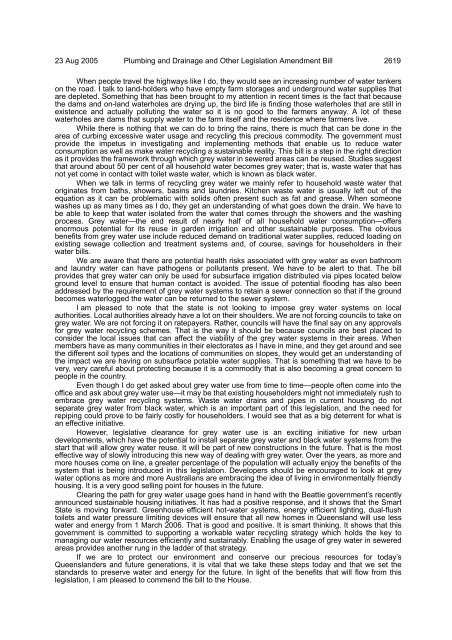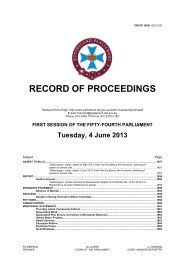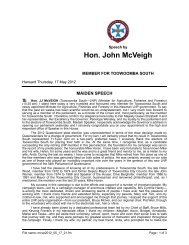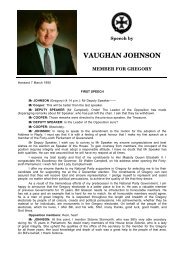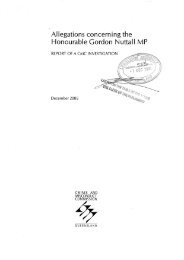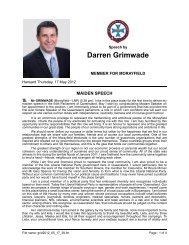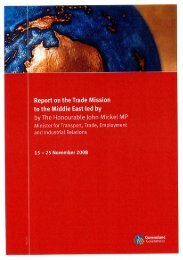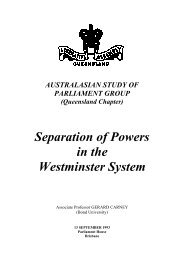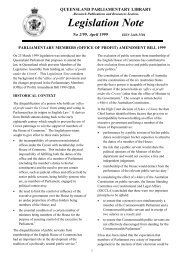weekly hansard - Queensland Parliament - Queensland Government
weekly hansard - Queensland Parliament - Queensland Government
weekly hansard - Queensland Parliament - Queensland Government
You also want an ePaper? Increase the reach of your titles
YUMPU automatically turns print PDFs into web optimized ePapers that Google loves.
23 Aug 2005 Plumbing and Drainage and Other Legislation Amendment Bill 2619<br />
When people travel the highways like I do, they would see an increasing number of water tankers<br />
on the road. I talk to land-holders who have empty farm storages and underground water supplies that<br />
are depleted. Something that has been brought to my attention in recent times is the fact that because<br />
the dams and on-land waterholes are drying up, the bird life is finding those waterholes that are still in<br />
existence and actually polluting the water so it is no good to the farmers anyway. A lot of these<br />
waterholes are dams that supply water to the farm itself and the residence where farmers live.<br />
While there is nothing that we can do to bring the rains, there is much that can be done in the<br />
area of curbing excessive water usage and recycling this precious commodity. The government must<br />
provide the impetus in investigating and implementing methods that enable us to reduce water<br />
consumption as well as make water recycling a sustainable reality. This bill is a step in the right direction<br />
as it provides the framework through which grey water in sewered areas can be reused. Studies suggest<br />
that around about 50 per cent of all household water becomes grey water; that is, waste water that has<br />
not yet come in contact with toilet waste water, which is known as black water.<br />
When we talk in terms of recycling grey water we mainly refer to household waste water that<br />
originates from baths, showers, basins and laundries. Kitchen waste water is usually left out of the<br />
equation as it can be problematic with solids often present such as fat and grease. When someone<br />
washes up as many times as I do, they get an understanding of what goes down the drain. We have to<br />
be able to keep that water isolated from the water that comes through the showers and the washing<br />
process. Grey water—the end result of nearly half of all household water consumption—offers<br />
enormous potential for its reuse in garden irrigation and other sustainable purposes. The obvious<br />
benefits from grey water use include reduced demand on traditional water supplies, reduced loading on<br />
existing sewage collection and treatment systems and, of course, savings for householders in their<br />
water bills.<br />
We are aware that there are potential health risks associated with grey water as even bathroom<br />
and laundry water can have pathogens or pollutants present. We have to be alert to that. The bill<br />
provides that grey water can only be used for subsurface irrigation distributed via pipes located below<br />
ground level to ensure that human contact is avoided. The issue of potential flooding has also been<br />
addressed by the requirement of grey water systems to retain a sewer connection so that if the ground<br />
becomes waterlogged the water can be returned to the sewer system.<br />
I am pleased to note that the state is not looking to impose grey water systems on local<br />
authorities. Local authorities already have a lot on their shoulders. We are not forcing councils to take on<br />
grey water. We are not forcing it on ratepayers. Rather, councils will have the final say on any approvals<br />
for grey water recycling schemes. That is the way it should be because councils are best placed to<br />
consider the local issues that can affect the viability of the grey water systems in their areas. When<br />
members have as many communities in their electorates as I have in mine, and they get around and see<br />
the different soil types and the locations of communities on slopes, they would get an understanding of<br />
the impact we are having on subsurface potable water supplies. That is something that we have to be<br />
very, very careful about protecting because it is a commodity that is also becoming a great concern to<br />
people in the country.<br />
Even though I do get asked about grey water use from time to time—people often come into the<br />
office and ask about grey water use—it may be that existing householders might not immediately rush to<br />
embrace grey water recycling systems. Waste water drains and pipes in current housing do not<br />
separate grey water from black water, which is an important part of this legislation, and the need for<br />
repiping could prove to be fairly costly for householders. I would see that as a big deterrent for what is<br />
an effective initiative.<br />
However, legislative clearance for grey water use is an exciting initiative for new urban<br />
developments, which have the potential to install separate grey water and black water systems from the<br />
start that will allow grey water reuse. It will be part of new constructions in the future. That is the most<br />
effective way of slowly introducing this new way of dealing with grey water. Over the years, as more and<br />
more houses come on line, a greater percentage of the population will actually enjoy the benefits of the<br />
system that is being introduced in this legislation. Developers should be encouraged to look at grey<br />
water options as more and more Australians are embracing the idea of living in environmentally friendly<br />
housing. It is a very good selling point for houses in the future.<br />
Clearing the path for grey water usage goes hand in hand with the Beattie government’s recently<br />
announced sustainable housing initiatives. It has had a positive response, and it shows that the Smart<br />
State is moving forward. Greenhouse efficient hot-water systems, energy efficient lighting, dual-flush<br />
toilets and water pressure limiting devices will ensure that all new homes in <strong>Queensland</strong> will use less<br />
water and energy from 1 March 2006. That is good and positive. It is smart thinking. It shows that this<br />
government is committed to supporting a workable water recycling strategy which holds the key to<br />
managing our water resources efficiently and sustainably. Enabling the usage of grey water in sewered<br />
areas provides another rung in the ladder of that strategy.<br />
If we are to protect our environment and conserve our precious resources for today’s<br />
<strong>Queensland</strong>ers and future generations, it is vital that we take these steps today and that we set the<br />
standards to preserve water and energy for the future. In light of the benefits that will flow from this<br />
legislation, I am pleased to commend the bill to the House.


